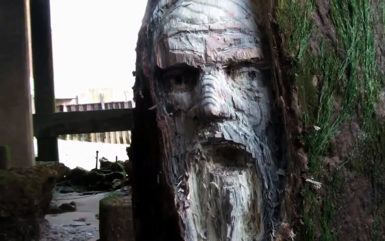
The Pillars of the Empire
2011
Video / 03:09’
Colección MICROMUSEO ("al fondo hay sitio")
Jaime Miranda Bambarén
(Monumento Films)
The Pillars of the Empire
2011
Video / 03:09′
Colección MICROMUSEO
(“al fondo hay sitio”)
Derechos reservados (Copyright):
Jaime Miranda Bambarén
Transparencia (Disclosure):
este video entrelaza ficciones y datos reales
(this video interweaves fiction and fact)
Sinopsis del artífice:
“Los pilares del Imperio es una intervención en los restos arqueológicos de un antiguo muelle naviero en Greenwich, sobre el río Támesis, en lo que fuera la zona portuaria de Londres. Mientras tallaba ese esqueleto de madera sentí que descubría un mensaje de la naturaleza. Era como un chamán jugando con los huesos del Imperio Británico y los símbolos de poder material ubicados alrededor de estas nuevas esculturas. La Old Royal Naval College, el centro financiero Canary Wharf. Y el propio meridiano de Greenwich: el Meridiano Cero, el Meridiano Primordial.
Para ver las esculturas, es necesario recorrer esos muelles cuando el Támesis se encuentra en marea baja.
Ubicación: 51° 29’ 38.60’N 0° 0’ 5.00’E”.
(Jaime Miranda Bambarén)
Artificer’s statement:
“The Pillars of the Empire is an intervention on the archaeological remains of an old pier in Greenwich, over the river Thames, in what used to be the port area of London. While I was carving that wooden skeleton I felt I was uncovering a message from nature. I was like a shaman playing with the British Empire’s bones and the symbols of material power located in the surroundings of these new sculptures. The Old Royal Naval College, the Canary Wharf financial district. And the Greenwich meridian line itself: the Prime Meridian.
To see the sculptures it is necessary to walk through those piers when the Thames is at low tide.
Location: 51° 29’ 38.60’N 0° 0’ 5.00’E”.
(Jaime Miranda Bambarén)
Jaime Miranda at Chelsea College of Art and Design,
PgDip Fine Art Interim Exhibition
In this interim exhibition of work by post-graduate students of Chelsea College of Art and Design, Peruvian artist Jaime Miranda’s photographs stand out for their direct engagement with our city and the powerful challenge they make to our belief systems.
Miranda photographs a project space he has created for himself in a secret location under a pier on the banks of the river Thames. Working with the space as his studio, Miranda carves into the wooden remains of a pier, which stand out of the ground like reminders of a past civilisation. Working at low tide he makes himself at home, being pushed out by the river itself when the water rises to cover his creations. With the business centre of Canary Wharf towering over him as a backdrop Miranda, in his carvings, seeks to reignite a connection with the city around us by working directly on its features.
Using the traditional tools of a chisel and hammer Miranda carves into the wood, to reveal its hidden personality and spirit. He peels back the accumulated moss and chisels away at the structures as though he is only intervening to set free a face that always existed within it. It is as though Miranda serves only to uncover the hidden energy and personality beneath the surface of the structure, revealing a spirit that has in recent years become obscured.
Miranda taps into a different, perhaps more primitive, more direct relationship with nature and a society’s deeper connection with its surroundings. In these photographs nature emerges with its own force and the wooden structure becomes a totem to a lost society and belief system. Miranda highlights our contemporary disconnection with nature and our ignorance of its power and personality.
Floating above Miranda, working at his sculptures, is that powerful British emblem of business and the capitalist agenda, Canary Wharf. In the business world there is no space for Miranda’s excavations. Time itself has become a commodity and capitalist priorities surpass concerns with the natural environment around us. The buildings float above Miranda’s head almost as a threat and we are made aware of their controlling power in our world.
Miranda comes from Peru where capitalism has had a huge impact on the local way of life and environment seen in particular in the commodification and loss of large sections of the Amazon rainforest. In these photographs Miranda addresses one of the centres of that ideology and seeks to question its dominance. He sets up a narrative whereby our relationship to the natural world has changed. He asks us to look at how we live, at our concept of time, at our concept of nature and he questions how we arrived there.
(Kate Neave
May 19th, 2011)
(https://kateneave.squarespace.com/articles/jaime-miranda-at-chelsea-college-of-art-and)
